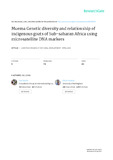| dc.description.abstract | Sub-Saharan African goats with an estimated population of 180 millions are major asset for farmer communities in
a range of agro-ecological zones. This study was undertaken to determine the genetic diversity in and
differentiation of relationships among 18 populations of goats from Uganda (4), Tanzania (5), Kenya (2),
Mozambique (2), Nigeria (3), Mali (1) and Guinea Bissau (1). Heterozygosity, estimates of FST, genetic diversity
and distances were performed using data from 11 microsatellite DNA loci.
Expected heterozygosity ranged from 0.450 in Guinea Bissau population to 0.541 in Mbeya population (Tanzania),
while the observed heterozygosity ranged from 0.441 in Pafuri population (Mozambique) to 0.560 in Sebei
population (Uganda). Mean number of alleles (MNA) per population ranged from 3.82 to 5.91. Gene
differentiation (FST) among populations was low (5.3%), a result confirmed by genetic distances (DA).
Our results reveal that genetic relationships between populations reflect their geographical proximity rather than
morphological classification. | en_US |

